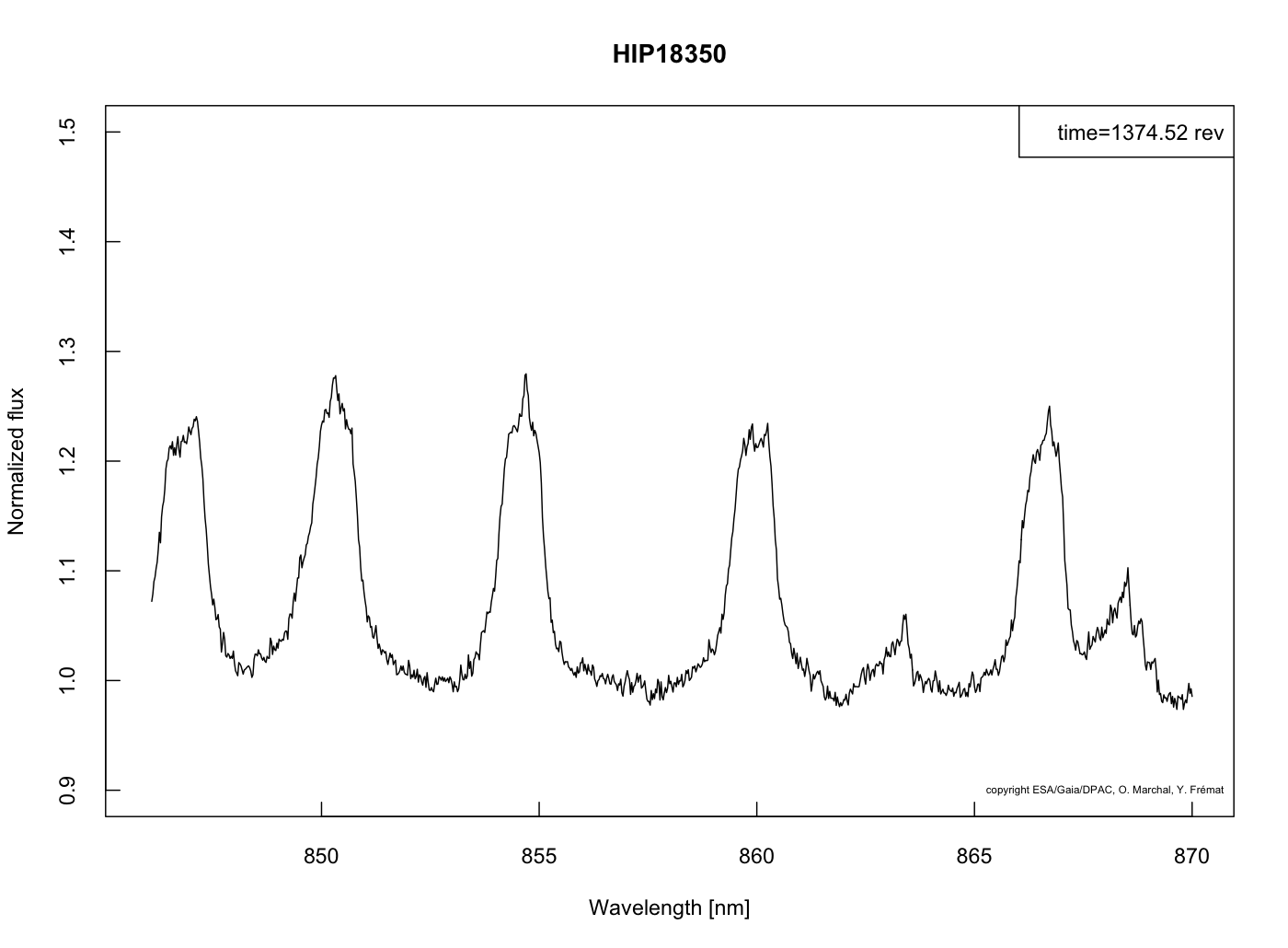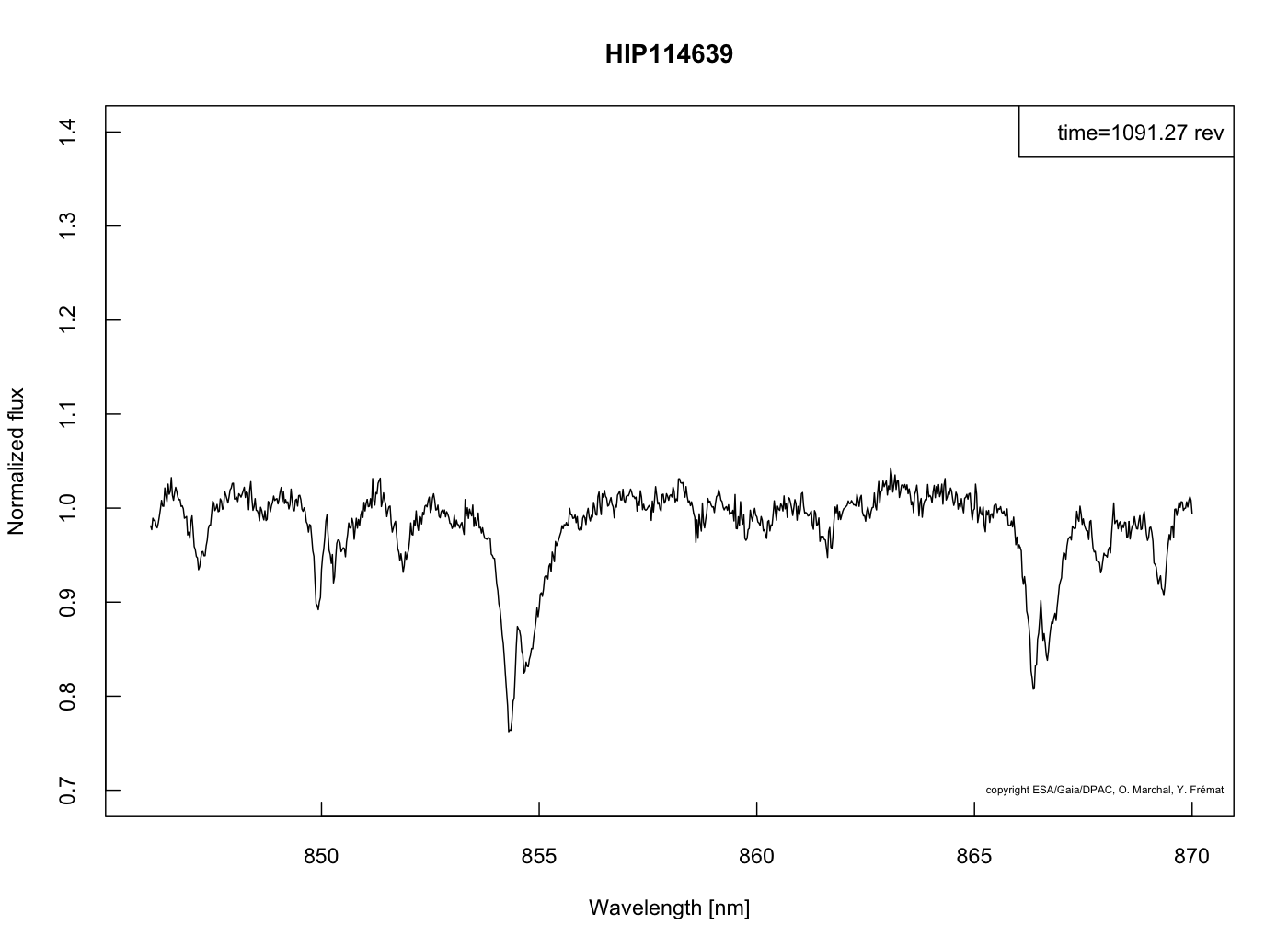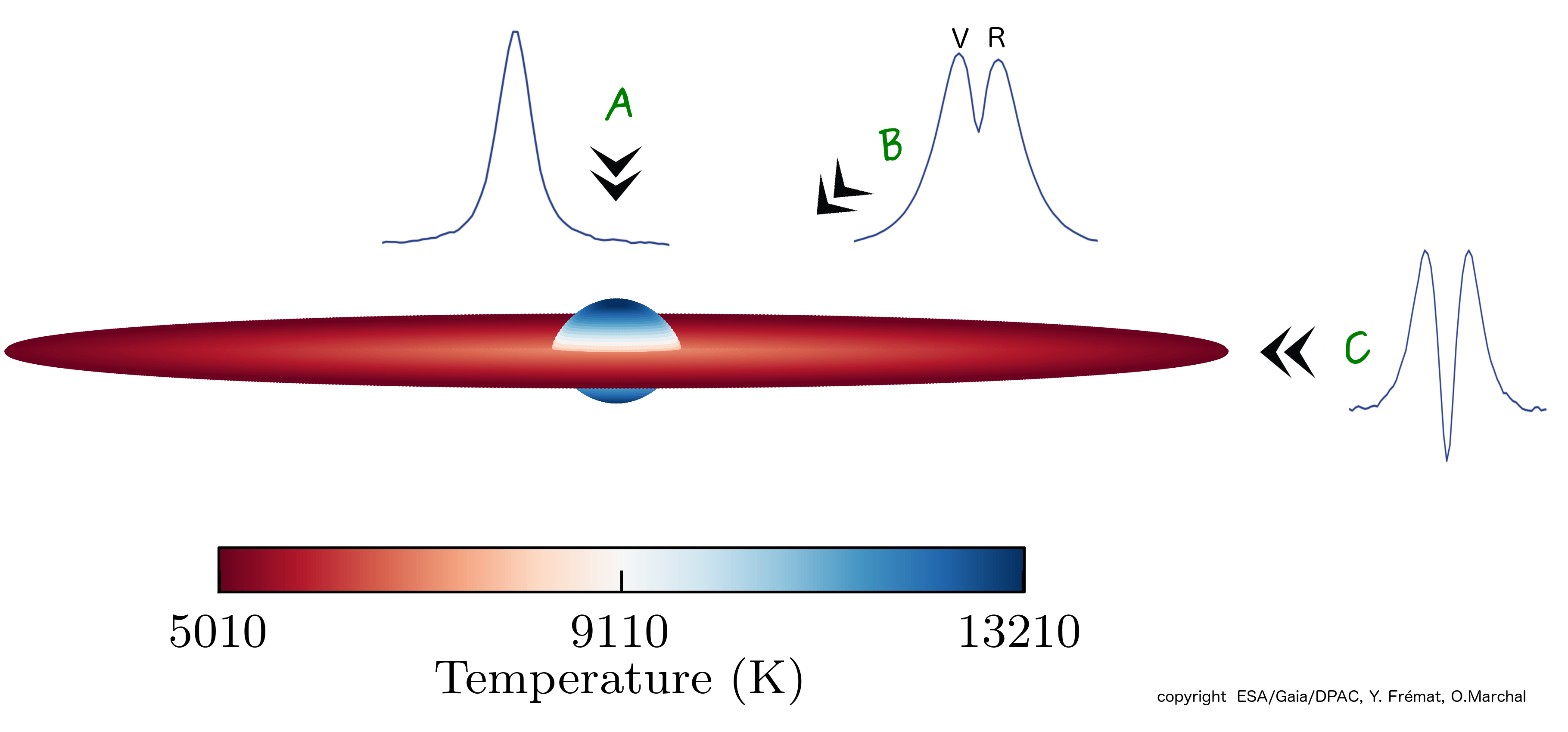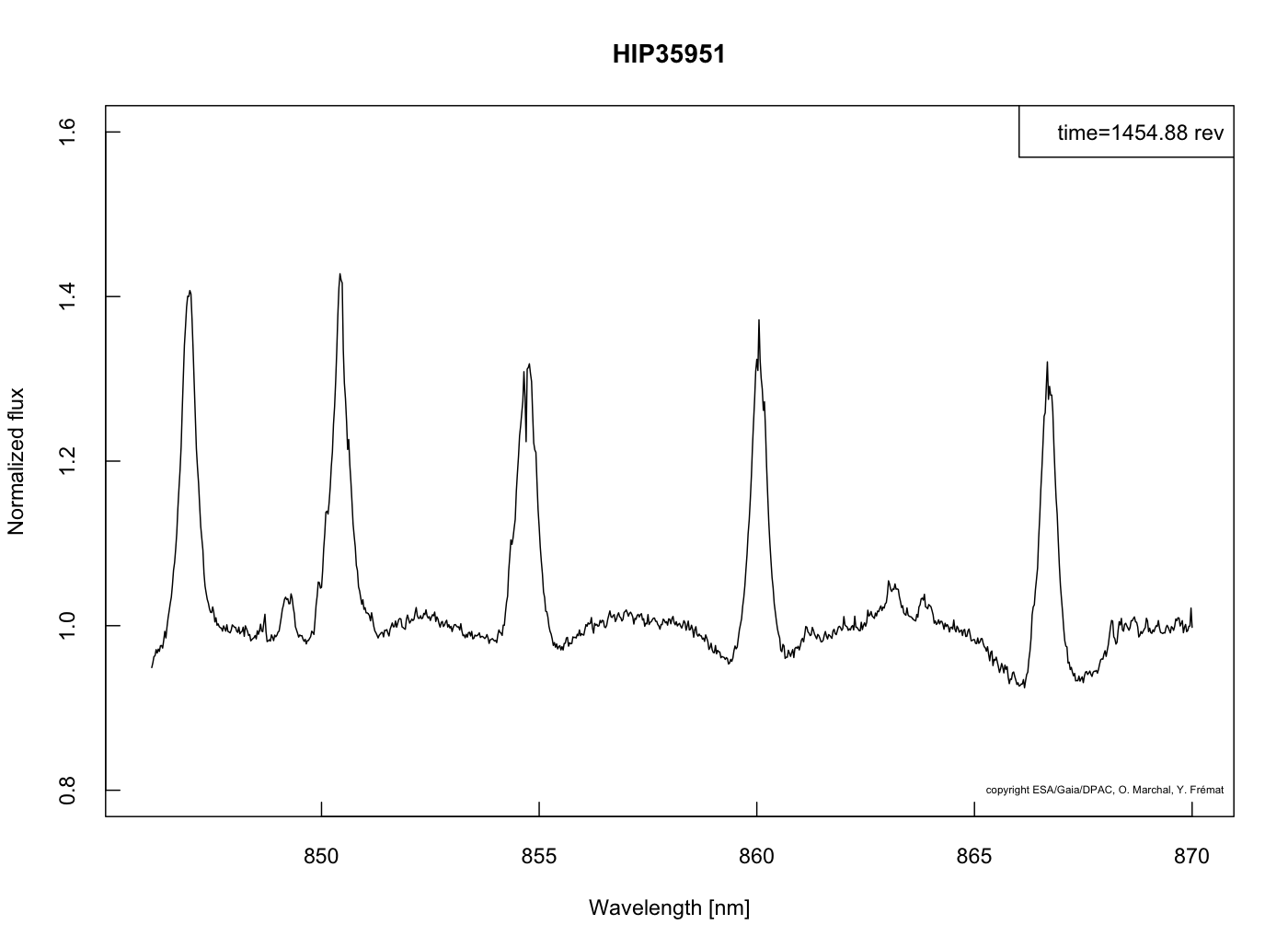IoW_20190529 - Gaia
Image of the Week |
Spectroscopic variability of emission lines stars with GAia |
|
|
|
Figure 1: RVS time series of X Per (HIP 18350). X Per is a member of the Be/X-ray class of binaries. The Be star (spectral type O9.5 III) has a neutron star companion that accretes the Be star circumstellar matter. The spectra show the typical Paschen lines in emission and a small nitrogen line around 863.5 nm. The double peaked shape of emission lines is due to a Keplerian rotating disc. In the first 22 months of the nominal mission, it was observed 28 times. Because of the orbital motion and the nature of the stellar components, the intensity and line-emission shape vary in time. Image credit: ESA/Gaia/DPAC/CU6-O.Marchal |
| During its mission, Gaia will scan all the sky in a repetitive way. The satellite spectrometer is expected to collect 6 billion spectra until the end of the mission and will provide thus access to all kind of objects until magnitude G=17. One of the key points of the survey is that every source will be observed about 8 times a year on average, which will allow the community to follow the evolution and the variation of the brightest sources through time. For the nominal mission, this will add up to about 40 observations on average, and with each mission extension this number will increase further. The Radial Velocity Spectrometer (RVS) aims to supply radial velocities of stars by measuring the Doppler shift of their spectral lines in absorption. A small fraction of stars may however exhibit line emission in their spectrum. The intensity and shape of the emission depend on the physical conditions, the radiation field and the geometry of its formation region. Emission can be due to chrosmospheric activity (like in RS CVn stars), caused by matter transfer and accretion processes in binary interactions, or it may originate either in extended stellar atmospheres or in stellar envelopes such as equatorial discs. Variable stars of type RS CVn are a good illustration of the first case, while Be (read “B”-“e” for B-type stars with emission lines) are representatives of the last one. In what follows we aim to provide a few time series examples of RVS spectra of these two categories of stars obtained during the validation of the spectroscopic processing. Because more upstream validation and treatment is needed still, the release of epoch RVS data is not foreseen for Gaia DR3, but for Gaia DR4. The figures below and above give a foretaste of the information contained in the emission-line star epoch spectra. Times in the graphics are given in units of Gaia's 6 hour revolution. RS CVn stars are detached binary systems showing evidence for intense magnetic activity which is observed by the impact of spot coverage and chromospheric activity on their light and spectrum behavior. They have at least one cool component because of the presence of Ca II, H and K emission in their spectra, whose strength can be used to measure the chromospheric activity. In the RVS spectra, weak emission is also expected to be detected in the Ca II infrared triplet (Ca IRT) at 850.04, 854.44 and 866.45 nm.
Figure 2: RVS time series of the RS CVn system SZ Psc (HIP 114639). SZ Psc is a double-lined binary (orbital period 3.97d), with partial eclipses made of a F8 V-IV and a K1 IV component. The contribution of the two stars are seen, and a weak reversal of the Ca IRT line-cores due to emission is observed at most epochs. Remarkably, at cycle/time 1541.97rev. the emission cores popped up above the continuum during only one transit. The time sampling of the RVS spectra is not regular, but the event appeared and disappeared in less than 15 days. Image credit: ESA/Gaia/DPAC/CU6-O.Marchal
Be stars form a class of main sequence stars which have emission (mainly in the Hα line) formed in a Keplerian equatorial disc or a ring-like envelope. According to Milky-Way surveys, about 20% of the main sequence B-type stars display the Be phenomenon. Usually their measured rotational speed is subcritical, but larger than 75 percent of the breakup value, which makes them the fastest rotators among the main sequence stars (with projected rotational velocities from a few 10 km/s up to more than 400 km/s). Due to the centrifugal force, rapid rotation strongly affects stellar evolution, flattens the star (e.g. Be star Achernar) and generates non-uniform surface temperature and density distributions that have sensitive impact on its spectrum. Together with non-radial pulsation and/or small-scale weak magnetic fields, rotation is also widely thought to play a key role in the formation of the circumstellar disc.
Figure 3: Schematic view of Be stars’ emission line-profiles seen at different inclination angles, from pole-on (A) to equator-on (C). The shape and nature of the equatorial rotating disc lead to double peaked aspect angle-dependent line emission profiles. The separation of the two peaks, V and R, depends on the inclination angle, the rotation rate and disc size. Image credit: ESA/Gaia/DPAC/CU6-O.Marchal,Y.Frémat
Although emission is the strongest in the Hα line, emission can be detected at all wavelengths, depending on the temperature and stellar inclination angle. In the RVS wavelength domain, early type Be stars often show the higher members of the hydrogen Paschen series in emission, from P17 to P13. Be stars are also photometric and spectroscopic variable stars, with rapid to long-term variations (from few days to several years). Emission lines are therefore variable too. Their strength, as well as the relative intensity of their Violet and Red (known as V/R variability) emission peaks can change during outburst periods, either due to their orbital motion if they are part of multiple systems, because of a one-armed oscillation pattern that propagates across the disc, or due to changes of the disc physical structure. Figure 4a and 4b: RVS time series of two single-line Be stars. FW CMa (HIP 35951 - Figure 4a - top) is of spectral type B3 V, while HIP 50044 (HD 88825 - Figure 4b - bottom) is a somewhat cooler B4 V star. Both sources have variable emission line-profiles superimposed to the photospheric absorption lines. The spectra of HIP 50044 show a clear contribution from the calcium triplet, stronger than the Paschen emission. The V/R variability is also stronger in this star. Image credit: ESA/Gaia/DPAC/CU6-O.Marchal
For further reading :
|
|
Credits: ESA/Gaia/DPAC/CU6, O. Marchal (CNRS/Observatoire de Paris), Y. Frémat (Royal Observatory of Belgium) [Published: 29/05/2019] |
- Removed a total of (16) style text-align:center;
- Removed a total of (4) style text-align:justify;
- Removed a total of (1) border attribute.
- Removed a total of (1) cellpadding attribute.
- Removed a total of (1) cellspacing attribute.
Image of the Week Archive
- Removed a total of (1) border attribute.
- Removed a total of (1) cellpadding attribute.
- Removed a total of (1) cellspacing attribute.








































 Sign in
Sign in
 Science & Technology
Science & Technology




